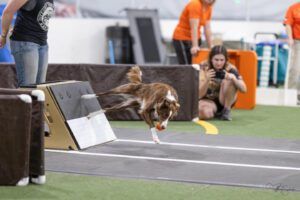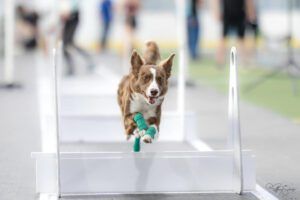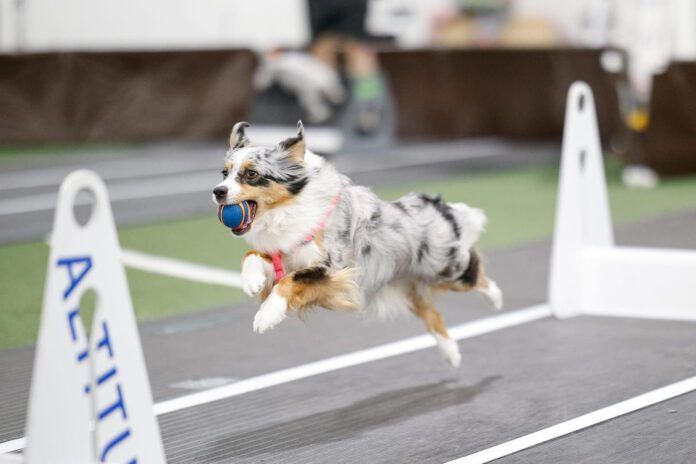Some dogs would play fetch all day long if they could. Flyball takes the game of fetch to the next level by adding hurdles, a box to turn on, and other dogs racing at the same time. If your dog has a lot of toy drive, loves to retrieve, and can work around other dogs in fast-paced environments, flyball is the canine sport to try out.
Flyball is a relay race for dogs, where teams compete against each other for title points and bragging rights. Dogs are released from the start line, where they dash over four hurdles to a flyball box. They then turn by running up onto the slanted side of the flyball box, which releases a ball from its holding spot in the corner. The dog needs to catch the ball as it’s released and run back over the four hurdles to the start line. The next dog is released behind the start line while the first dog is on its way back, and ideally the two dogs pass each other nose to nose at the start line.
How To Get Your Dog Started in Flyball
According to Tonia Tamburini, flyball competitor, instructor, and team captain of the Denver Speed Demons flyball club, any dog can learn to play flyball. “We have a wide variety of breeds and sizes that play,” she says. “Athletic, fast dogs with a lot of drive tend to be the fastest at flyball, and dogs that understand the game of fetch can usually pick up the game faster than ones that are not interested in fetching a ball.”
If your dog seems to fit the bill, there are a few steps you should take to get them involved in flyball:
- Find a Flyball Club
According to Lydia Goggin, owner and trainer at Be Right Back Flyball Club in Northern Colorado, folks new to the sport should first look for a flyball club in their area.
“A good place to start is the North American Flyball Association (NAFA) or United Flyball League International (U-FLI) website and look for the teams listed in your area,” she recommends. “You can also find lists of tournaments in your area and talk to teams directly. NAFA also has Regional Directors who can help you find a club in your area and I believe U-FLI has a similar position.”
- Start Training
The foundation training for flyball is similar to agility in that it requires a number of specific, proofed skills in order to play. Tamburini says that toy/tug drive, recall, box turns, and retrieving are the four main foundational behaviors your dog needs to learn when starting flyball training. Here’s why each one is important:
- Toy/Tug drive: Tamburini says that building strong toy/tug drive “will make your dog faster and will help reward the dog for playing correctly.”
- Recall: “Having consistent and fast recalls is an important part of the game”, Tamburini says. “After a dog is consistent alone, we practice recalls while racing other dogs which they have to ignore.”
- Box turn: “Dogs need to learn how to turn and push themselves off of the box with all four paws while also getting the ball,” Tamburini says. “They need to master the shape of the turn first, then we add the ball.”
- Retrieve: Tamburini says that dogs need to learn how to retrieve a “still” ball that is placed. This can be a change for dogs who are only used to retrieving balls or other objects that are thrown.
- Get on a Team
Since Flyball is a team sport, you’ll need a team of four dogs to compete in trials. Don’t worry about finding your own team though, getting involved in a club will point you in the right direction.
“Each club fields their own teams, so whichever club you are training with in your area will help put you on a team to play with,” says Goggin. “There are no height or speed requirements, and most clubs can accommodate faster or slower dogs. Small dogs are actually very nice to have because the smallest/shortest dog on the team sets the jump height!”
Don’t worry if your dog isn’t the fastest or most impressive on the team. “People love to watch all different types of dogs run and you will often see the silliest or slowest dogs being the crowd favorites,” says Goggin.
How Long Does Flyball Training Take?
Like agility, there can be a big learning curve when you first get started in flyball. Goggin tells folks “to expect about a year of training before being tournament ready (some dogs will take more time and some will take less).”
She recommends working on recall, basic obedience, and impulse control skills to give dogs a step up in training flyball skills. Tamburini recommends working on these foundational skills at home where possible. “Working on foundations at home will speed training up so you can focus on team skills at class/practice.”
Tamburini agrees with Goggin that getting competition-ready for flyball can take quite a while. “I’ve seen dogs that are competition ready within a year of starting training and I’ve seen others that take years and years,” she says. “There are many, many components that a dog has to master before being able to compete such as going over all of the jumps consistently, bringing the ball all the way back over the start line, passing dogs nose to nose, ignoring the dogs in the other lane, coming back to the handler consistently. It is really common for a dog to struggle with one of those components and it takes time to get them ready.”
If you’re interested in getting started in flyball, know that it will likely require months of consistent training before you’re truly ready to compete. If you want to try out a sport that takes less upfront training time, consider FastCAT or rally.
How to Find and Enter Flyball Events

Both of the two main flyball associations (NAFA and U-FLI) have sections on their websites to search for upcoming tournaments based on location. U-FLI allows you to search by state, while NAFA requires you to search by region. NAFA regions may contain just one state, or up to eight states depending on location. Dogs need to be 15 months or older to compete in flyball tournaments.
Unlike most other dog sports, Flyball entries typically need to be made as a team. Your team needs to be registered with the hosting organization of the tournament you’re interested in before you can enter. Some organizations offer singles or pairs competitions, but the bulk of flyball tournaments are focused on team events.
How to Earn Flyball Titles
Tamburini explains that teams are selected to compete against each other based on speed. “Teams of 4-6 dogs are entered with seed times for a tournament so teams are racing other teams with a similar speed in a division.”
As you compete against these teams, your team earns points towards winning their division. You can also accumulate titles if you compete in NAFA sanctioned tournaments. Goggin explains that you can accumulate points towards titles by completing team races, and the cleaner the run, the more points you get. “If all four dogs run under 24 seconds without human or dog faults they each get the maximum available points,” she says. “Fewer points are awarded for each clean heat run over 24 seconds, but under 32 seconds.”
Dogs that fault during their run must then rerun, and the first team with four dogs that all run clean will win. “Rerunning the dog adds to their overall time,” says Tamburini. “Common faults include fast starting or early passing, dropped balls, going around the jumps or crossing into the other lane.”
Should I Try Flyball With My Dog?

If you’re interested in trying out flyball, Goggin recommends stopping by a local tournament and talking to competitors to learn more. “Since flyball is a team sport, playing with other people that have the same goals and values that you do is so important,” she says. “We are all here to have fun with our dogs and it’s easier to do that if you’re having fun with the people you’re with!”
Goggin also recommends shopping around for a club, so don’t feel pressured to join the first club you come in contact with. “Most people will support trying to find the right fit,” she says.
Tamburini recommends that folks who get involved with flyball be prepared to work as a team. “Be ready to help your teammates train their dog, help your team with various jobs, be willing to compromise and do what’s best for the group,” she says.






